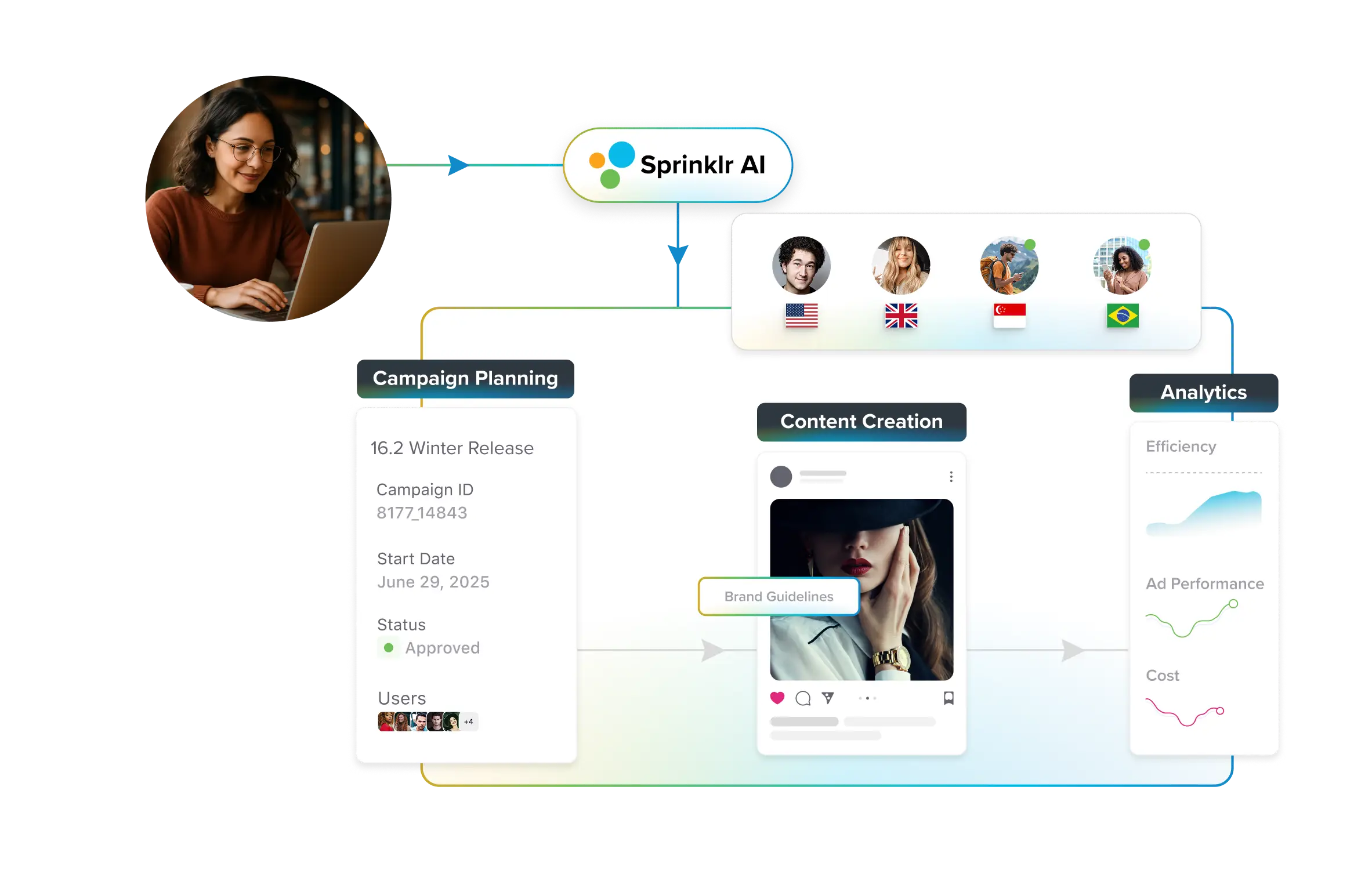The AI-native platform for global campaign management
Sprinklr Marketing unifies campaign planning, content creation, publishing and analytics across global teams — all elevated by AI. Accelerate go-to-market, boost performance and enforce brand governance at scale.

AI, Trust, and the New Customer: Marketing’s Mandate for Reinvention
The role of marketing has never been more critical or more complex. It is at a crossroads, caught between heightened customer expectations and fragmented technology ecosystems that can no longer keep pace. Today’s buyers move fluidly across channels, demanding experiences that are seamless, personalized, and effortless.
Meanwhile, companies are flooded with customer data but are struggling to activate it across disconnected systems. The traditional playbook and point solutions can no longer support the realities of the modern buyer journey. It’s time to retire legacy assumptions, rethink the tech, and reimagine marketing as the orchestrator of enterprise transformation.
But first, let’s take a step back and look at how we got to this inflection point and how marketing leaders can navigate the path forward with greater speed, precision, and impact.
AI is powering an Experience Revolution
AI is everywhere today, embedded into channels, touchpoints, and products, influencing every part of the customer journey. Embedded AI is shaping the CX. Take Sephora and Lenskart for instance. These brands allow customers to virtually try on their products before purchasing. What once required a trip to the store can now happen instantly, powered by AI. These experiences do not just reduce friction; they forge deep customer connections right from the very first interaction.
What we’re witnessing is a fundamental shift. AI is not just about automating processes but about enabling a more human-like interaction between brands and their customers, one that is more conversational and intuitive.
After all, conversation is the new UI.
Consumers are no longer interacting with brands through click-based, input-based workflows. Instead, brand-consumer interactions have become conversational, organic, and free flowing. AI empowers brands with the behavioral insights and historical context needed to make these interactions natural and intuitive.
Which brings me to Generative AI, the disruptive technology shaping customer interactions to a point where I can ask Alexa or Siri to order my pantry staples for me! It can not only make sense of my natural language prompt, but also find me the best bargains, add items to cart, and complete the payment, all by itself.
Evidently, GenAI has gone beyond understanding human prompts to automating the entire customer journey. But to harness these tactical advantages of AI, we need AI-native tools that are designed to automate and optimize customer journeys from start to finish.
Consumer focus and power have shifted
Speaking of buying journeys, we all know how complex and non-linear they’ve become. It’s now common for a buyer to discover your brand on social media, then check out your website, read reviews on Google, compare your prices on aggregator websites, before they finally make a purchase or decide to connect with you.
Modern buyers don't move in a straight line — they bounce between channels, influencers, and moments. We need to optimize for intent signals, not stages. One disconnected moment in the journey could repel the customer forever.
In between all this channel-hopping, one truth has become impossible to ignore: social is the new storefront. I think I speak for everyone when I state social is the new point of sale.
Discovery and purchase are converging — many customer journeys begin and end on social. 40% of Gen Z now starts product searches on social platforms, not Google. The US alone does $70B in revenue on social commerce, with TikTok alone doing $1B a month. Whether B2B or B2C, startup or enterprise, every business must elevate its social commerce capabilities to stay competitive and relevant.
In this new reality, a brand’s narrative is no longer centralized; it’s decentralized across every voice and touchpoint.
Gone are the days when paid endorsements and ads drove customer perception. Today, consumer perception is shaped by what consumers see and hear about your brand, from sources they trust. Your brand lives in what others say about you — employees, customers, partners — not just your website. It's a living, breathing ecosystem of narratives you don't always control but always want to monitor.
In such a high-stakes ecosystem, trust will be your only differentiator. When you lead with transparency, you win trust. Take Patagonia for instance. Despite zero marketing, it enjoys widespread popularity and monopoly because it observes full transparency in its supply chain. Clearly, customers love and trust the approach which is why they reward the brand with heaps of positive word of mouth!
Companies are demanding more from their marketing teams
In the middle of tech disruption and evolving customer expectations, marketing leaders are under pressure to do more than execute; they’re expected to architect growth. Believe me when I say the pressure is as much internal as its external. The external headwinds are real, but the bigger challenge lies in how we, as CMOs, reimagine marketing from the inside out.
I read a recent CMO Council survey saying that 65% of CMOs feel marketing must own and optimize the company’s revenue generation engine, influencing everything from product strategy to digital sales. Marketing will own a stake and possibly lead the discussion on not only how to market, but also what and why to market. The expanded job description will require you to be armed with:
- Comprehensive intelligence on the customers’ needs and preferences to drive hyper-personalized engagement
- Agility and foresight to respond fast to emerging customer behaviors, channels, and technology
- Tools and systems that allow you to monitor and manage marketing experiences, almost in real time
Winning in this new era means mastering three essentials: deep customer intelligence, real-time agility, and connected technology ecosystems. The future of marketing leadership isn’t about doing more; it’s about doing the right things, faster and smarter. Those who can integrate data, intuition, and rapid execution will lead; those who can't, will be left behind.
Reinvent marketing through ecosystem thinking
I understand that over the years, CMOs have built the marketing function and tools to deliver on specific outcomes. For example, you might use one tool for content planning, another for content deployment, and a third one for gathering analytics data. But this has resulted in a fragmented MarTech stack, riddled with limitations like low data interoperability, low value realization with AI, and broken brand experiences.
Piecemeal tools for different channels, touchpoints, and business units will amount to disconnected efforts and lost opportunities. Imagine a massive, mobile, user-connected world where billions of buyers share breadcrumbs of personal intelligence and purchase intent daily, but all this rich data is locked away within different tools and teams! The data is there; it’s just not activated enough to deliver any meaningful business value.
The solution? An ecosystem-led approach to MarTech that entails:
- Activating data across tools and touchpoints, empowering all your teams with insights.
- Switching from piecemeal AI capabilities to a broad AI strategy that supports cross-functional automations and insights.
- Orchestrating unified and brand-compliant experiences across the customer journey.
Forrester also recommends creating a MarTech Ecosystem that prioritizes interoperability to support data, orchestration across the customer journey, and emerging AI capabilities.
Taking the cue, smart brands like Diageo have switched to unified solutions that can detect trends decades into the future, understand where the market is headed, and deliver business intelligence that can then inform the business strategy. This level of data interoperability and seamlessness would be virtually impossible had Diageo used separate tools for every channel and team.
Transformation isn’t a choice; it’s marketing’s new mandate
Before I wind up, I’ll say this much — the marketing playbook (as we know it) is gone and maybe that’s a good thing. It marks a defining moment for marketing leaders to reset the rules of the game. The path to clarity begins with making tough choices: breaking down silos, replacing point solutions, and transforming MarTech into your hero, not a financial burden. It demands decisive leadership — clarity of vision, agility of action, and full alignment with enterprise outcomes.
The crossroads is here. The path forward is clear.
It is time to unify, elevate, and transform.











